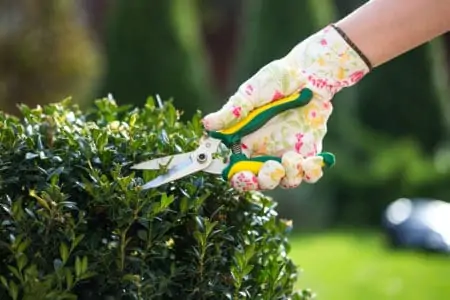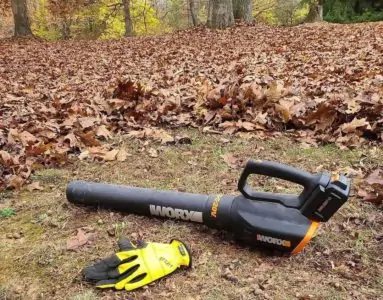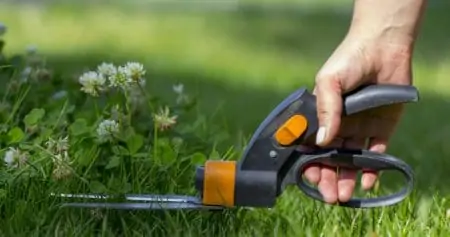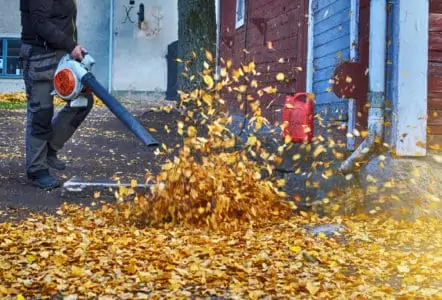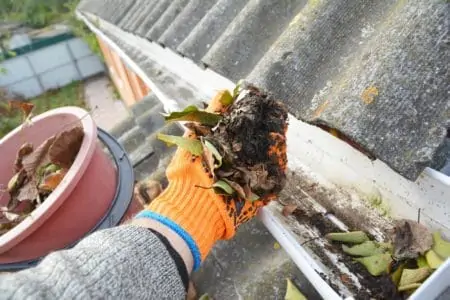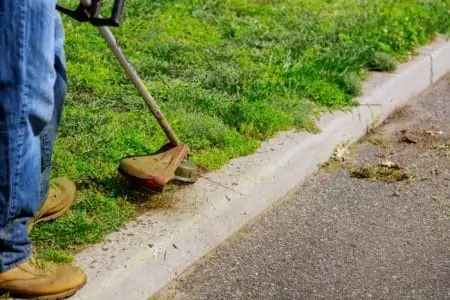My husband is great at trimming bushes and hedges. All of our neighbors would knock on our door to ask him if he could just do it for him.
So if the bushes and hedges in your yard are out of hand, you’re in the right place. We have some great guidance on how to trim bushes and hedges so you have one of the best-looking yards on the street.
Key Takeaways
- Use the proper tools like pruning shears, loppers, pruning saws, and hedge shears for trimming bushes and hedges.
- Trim bushes by cutting off dead stems and branches, pruning overgrown areas, and removing suckers, waterspouts, and canes.
- When trimming hedges, use hedge shears for overgrowth and powered hedge trimmers for a full trim, ensuring an even cut and proper shape.
- The best time to trim bushes and hedges is during late winter or early spring, avoiding nesting season for birds.
What to Use for Trimming Bushes and Hedges
Before you get to trimming, you need to know the best tools to use. This differs for bushes and hedges, so make sure you choose according to what you’ll be trimming.
For Trimming Bushes
There are a few things you can use for trimming bushes.
Pruning Shears
Pruning shears are little handheld tools that look similar to scissors. They can be used for bushes, shrubs, vines, flowers, and even trees.
For bushes, we specifically recommend bypass shears which act like scissors and can cut off excess growth, including leaves and stems.
Pruning Saw
You may want to try a pruning saw if you need to be cutting branches. These can cut branches up to 5 inches in diameter, so if your bush has thicker branch types, then this is a handy tool to use.
Lopper
A lopper is great for bushes, too. This works on branches up to 2.5 inches thick, so it’s not as intense as a pruning saw. Loppers are especially useful on fruit and nut trees, as well as vines.
Hedge Shears
Hedge shears can be used for both hedges and bushes, making them very versatile. You can also use them for shrubs, evergreens, and perennials.
For Trimming Hedges
When trimming hedges, there are a few tools you may use. Check out which each one is for, as this will determine which is best for you.
Hedge Shears
You can also use hedge shears for hedges. As mentioned, they are versatile tools that can be used for both trimming back leaves but also branches up to 2.25 inches thick, depending on the shears you choose.
Powered Hedge Trimmers
For big jobs that require even and quick results, you should go for a powered hedge trimmer. These are available as gas or electric.
If choosing electric, you’ll have both the option for corded and cordless. These are easy and fun to use, but they are also sharp and dangerous if you don’t use them properly. Always follow safety precautions and read the user manual before starting up the tool.
How to Trim Bushes
Let’s look at a step-by-step guide to get those bushes trimmed and tidy.
- Make a disinfecting solution: Make a solution of 10 percent bleach with 90 percent water in a bucket. You will dip your tool in here between uses when cutting off dead parts so as not to transfer any diseases.
- Cut off dead stems: Start by cutting off dead stems. These are ugly, but they can also attract insects. For this, you can use pruning shears or a hedge shear. Make sure to dip your tools in the solution between cuts to avoid disease transfer.
- Cut off dead branches: Next, move to dead branches. You can identify if a branch is dead by whether it looks dried, wilted, weak, or different from the healthy branches. If you find damaged branches, even if they don’t look bad yet, cut them off, too. Depending on the thickness of the branches, you may want to switch over to hedge shears, a pruning saw, or a lopper here.
- Prune: Now it’s time to prune back anything that doesn’t look right or is overgrown. You will also want to cut away anything that is growing in the opposite direction from the rest of the bush, as this will make the bush look odd. This includes branches mostly, as they can grow in wild directions in the center of the bush.
- Remove other parts: You should also now remove suckers, waterspouts, and canes. This will improve the overall health of the bush.
- Thin the bush: If you feel that any spots are too thick and don’t match with the rest of the bush, thin out these parts too. You don’t need to remove branches entirely, but you can cut new thinner stems. Just make sure to cut at the collar where branches connect so the bush can heal over.
Top Tip
When pruning, start with the oldest and largest branches and work your way back. This will help you keep everything to the same height.
How to Trim Hedges
Whether you’re using hedge shears or a powered trimmer, the instructions will vary. We’ve made a guide for either tool. Ultimately, it’s a good idea to use hedge shears and then a powered trimmer for awesome results.
With Hedge Shears
- Plan ahead: You’ll want a nice even cut, so plant some stakes and tie a string at your desired height. This will help you keep everything even. You’ll thank yourself later.
- Start cutting: Hold the shears horizontal and start cutting evenly across the top of the hedge. Only trim up to one year’s worth of growth otherwise, you can damage the hedge. Make sure to cut at the stems rather than the leaves for a nice clean cut.
That’s all there is to cutting with hedge shears. They are not for a full hedge haircut but rather trimming overgrowth. You will want to go in with a powered hedge trimmer for the full cut.
Expert Advice
When trimming overgrowth with hedge shears, make sure to keep the base of the hedge wider than the top so that the sunlight can get through to the bottom branches.
With Powered Trimmer
This is what you should use for a full hedge trim. It’s quicker and much more effective.
- Prepare: Before getting started, make sure to read the user manual and wear the recommended safety gear for your chosen model.
- Bottom up: Hold the hedge trimmer so it’s lying flat against the hedge, rather than side to side. Start at the bottom and move the cutting bar slowly upwards. The blades will do the work, so don’t push against the head, or you may cut off too much. It’s better to go in a few shallow movements, taking off a little each time, than trying to do it all in one go.
- Go at an angle: Try and trim the sides of the hedge at an angle to allow for a narrow top and wider bottom. This allows sunlight to get to the roots for optimal growth.
- Move to the top: To do the top of the hedge, hold the trimmer’s cutting bar level with the top and slowly move from left to right, then right to left. Otherwise, you can cut the top with hedge shears.
- Remove excess pieces: Use your hands or a leaf rake to remove cut branches and leaves that are stuck in or on the hedge.
- Final touches: If necessary, use hedge shears to make final touches and ensure the hedge is in your desired shape.
- Look inside: Use your hands to move the branches and look inside the hedge for dead or damaged branches. Cut them out with bypass hand pruners. If the branches are too thick, try a pruning saw or a lopper.
When Is the Best Time to Trim Bushes and Hedges?
It’s best to trim your hedges when the sun isn’t too intense. A cloudy day is preferred, but otherwise, choose early morning or late afternoon. This is so the sun doesn’t burn the freshly cut ends of the branches.
In terms of when is the best time during the year, any time is fine except nesting season in case there are birds living in your hedges. You may have to trim your hedges a few times. Once at the end of winter and at the end of summer is ideal.
FAQs
How to Maintain Hedges
Having a hedge as part of your outdoor area is a lovely thing. It’s important to maintain the hedges, so they remain healthy all year round. Here are our top tips:
- Keep the hedges wider at the bottom than the top: This allows for sunlight to get to the bottom so that the hedge is healthy all the way through.
- Only cut when necessary: If your annual hedge trimming time comes around and your hedge doesn’t need to be trimmed, skip it. Too much trimming can inhibit growth.
- Prune regularly: Use your hands to look inside the hedge to see if there are damaged or diseased parts. Remove them as soon as you notice them.
- Combine trimming, shearing, and pruning: While you can shear by hand, it will take longer. You should ideally combine trimming, shearing, and pruning for the health of your hedge.
- Weed regularly around the base of your hedge: Do this by hand to ensure that you do a thorough job.
- During dry spells, use a slow-release fertilizer: This is not necessary, but it can definitely help. Make sure to water the fertilizer well.
Beautiful Bushes and Handsome Hedges
When you have bushes and hedges, caring for them is very important. With our step-by-step guide for trimming both bushes and hedges, you can stay on top of your plant’s health and appearance.
Just make sure to use the right tools, follow the instructions well, and don’t forget to maintain the bushes and hedges between trimming.
